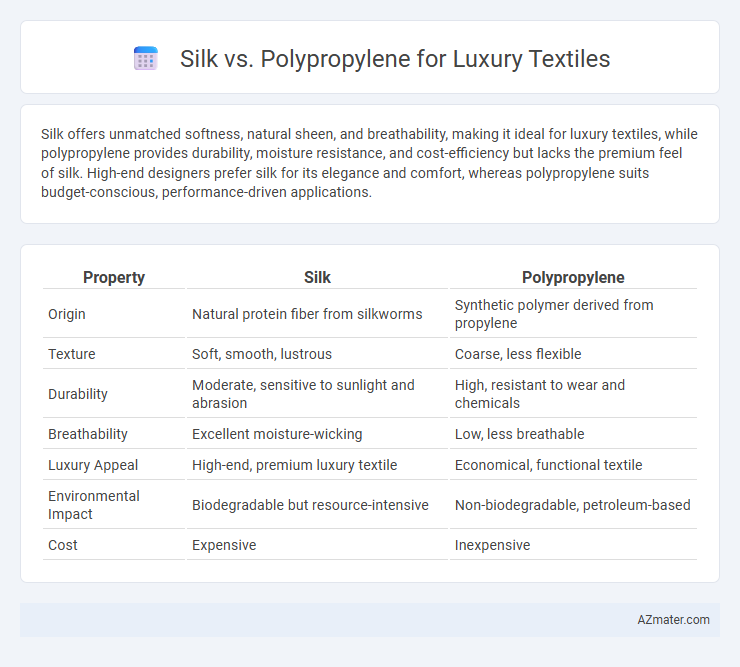Silk offers unmatched softness, natural sheen, and breathability, making it ideal for luxury textiles, while polypropylene provides durability, moisture resistance, and cost-efficiency but lacks the premium feel of silk. High-end designers prefer silk for its elegance and comfort, whereas polypropylene suits budget-conscious, performance-driven applications.
Table of Comparison
| Property | Silk | Polypropylene |
|---|---|---|
| Origin | Natural protein fiber from silkworms | Synthetic polymer derived from propylene |
| Texture | Soft, smooth, lustrous | Coarse, less flexible |
| Durability | Moderate, sensitive to sunlight and abrasion | High, resistant to wear and chemicals |
| Breathability | Excellent moisture-wicking | Low, less breathable |
| Luxury Appeal | High-end, premium luxury textile | Economical, functional textile |
| Environmental Impact | Biodegradable but resource-intensive | Non-biodegradable, petroleum-based |
| Cost | Expensive | Inexpensive |
Introduction to Luxury Textiles: Silk and Polypropylene
Silk, prized for its natural luster, breathability, and hypoallergenic properties, remains a hallmark of luxury textiles with a rich history in high-end fashion and decor. Polypropylene, a synthetic fiber known for its durability, moisture resistance, and cost-effectiveness, is increasingly utilized in performance-oriented luxury applications where practicality complements style. The contrast between silk's organic elegance and polypropylene's engineered resilience highlights evolving consumer demands and innovations in luxury textile manufacturing.
Defining Silk: Natural Elegance and Heritage
Silk, renowned for its natural elegance and rich heritage, is a protein fiber produced by silkworms, prized in luxury textiles for its smooth texture, lustrous sheen, and exceptional breathability. Unlike synthetic polypropylene, silk offers superior moisture absorption and temperature regulation, enhancing comfort and durability in high-end garments and upholstery. Its centuries-old cultural significance and eco-friendly biodegradability make silk a symbol of sophistication and sustainability in luxury fabric markets.
Polypropylene: The Modern Synthetic Alternative
Polypropylene offers a durable, lightweight, and moisture-resistant alternative to traditional silk in luxury textiles, making it ideal for high-performance applications. This modern synthetic fiber resists stains and mildew, providing longevity and easy maintenance without compromising on softness or aesthetic appeal. Its cost-effectiveness and versatility enable designers to create innovative, luxurious fabrics that meet both functional and style demands.
Luxurious Texture: Comparing Handfeel and Appearance
Silk offers an unparalleled luxurious texture characterized by its smooth, soft handfeel and natural sheen, making it ideal for high-end luxury textiles. Polypropylene, while durable and lightweight, lacks the same softness and subtle luster, resulting in a more utilitarian appearance. The intrinsic protein fibers of silk provide a richer tactile experience and aesthetic depth compared to the synthetic, less pliable polypropylene fibers.
Durability and Longevity: Silk vs. Polypropylene
Silk offers a natural fiber characterized by moderate durability but requires delicate care to maintain its luxurious appearance and strength over time. Polypropylene, a synthetic fiber, provides exceptional resistance to wear, moisture, and chemicals, making it significantly more durable and longer-lasting in various environmental conditions. For luxury textiles demanding both elegance and extended lifespan, polypropylene is often preferred due to its ability to withstand heavy use without degrading.
Maintenance and Care Requirements
Silk demands delicate maintenance with hand washing or dry cleaning to preserve its natural fibers, as it is sensitive to water, heat, and harsh chemicals, while polypropylene offers low-maintenance care through machine washable and quick-drying properties. Silk's natural protein structure requires gentle handling to prevent damage and maintain its luxurious texture and sheen, whereas polypropylene resists stains, mold, and fading, making it ideal for easy, durable upkeep. Choosing between silk and polypropylene depends on the desired balance of luxury feel versus practicality in textile maintenance.
Environmental Impact and Sustainability Considerations
Silk production involves natural fibers derived from silkworms, resulting in a biodegradable and renewable textile with a lower carbon footprint compared to synthetic alternatives. Polypropylene, a petroleum-based polymer, poses environmental challenges due to its non-biodegradability and reliance on fossil fuels, leading to increased microplastic pollution and higher greenhouse gas emissions. Sustainable luxury textiles prioritize silk for its eco-friendly lifecycle, while polypropylene's environmental impact raises concerns for long-term sustainability in fashion.
Cost Comparison: Investment Value in Luxury Textiles
Silk commands a significantly higher price point than polypropylene due to its natural origin, intricate harvesting process, and superior aesthetic qualities, making it a premium investment in luxury textiles. Polypropylene offers cost-effective durability and stain resistance but lacks the nuanced texture and breathability of silk, which justifies silk's elevated market value despite its higher maintenance requirements. Investors in luxury textiles often prioritize silk for its timeless appeal and long-term value retention, whereas polypropylene suits budget-conscious projects with a focus on functionality over prestige.
Design Versatility: Patterns and Color Retention
Silk offers exceptional design versatility with its natural sheen and ability to hold vibrant colors, making patterns appear rich and detailed for luxury textiles. Polypropylene exhibits strong color retention and durability, maintaining pattern integrity even after multiple washes, ideal for high-performance luxury fabrics. Both materials enhance design options, but silk is favored for intricate, luxurious patterns while polypropylene excels in long-lasting, fade-resistant designs.
Choosing the Best Material for Luxury Textiles
Silk offers unparalleled softness, natural breathability, and a lustrous sheen, making it a top choice for luxury textiles that emphasize comfort and elegance. Polypropylene excels in durability, moisture-wicking properties, and resistance to stains, suited for high-performance luxury garments that require longevity and easy maintenance. Selecting between silk and polypropylene depends on prioritizing either traditional luxury aesthetics or advanced functional benefits in high-end textile applications.

Infographic: Silk vs Polypropylene for Luxury textile
 azmater.com
azmater.com